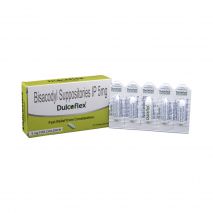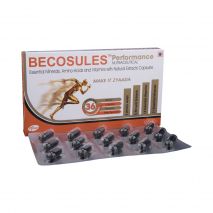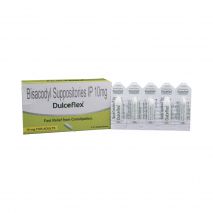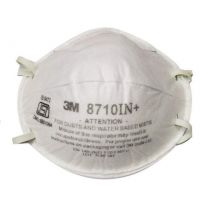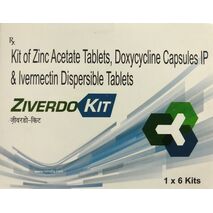Please sign in so that we can notify you about a reply
DULCOFLEX BISACODYL 5 mg TABLET
Composition
Tablet
Each enteric –coated tablet contains – Bisacodyl IP…….5 mg
Excipients ………q.s
Color : Ferric oxide yellow USP NF Titanium dioxide IP
Indications
For use in patients suffering from constipation.
For preparation of diagnostic procedures, in pre- and postoperative treatment and in conditions which require defecation to be facilitated.
Dosage and administration
Unless otherwise prescribed by the physician, the following dosages are recommended:
For constipation:
Adults
1 - 2 coated tablets (5 - 10 mg) daily
It is recommended to start with the lowest dose. The dose may be adjusted up to the maximum recommended dose to produce regular stools.
The maximum daily dose should not be exceeded.
Pediatric population
Children > 10 years:
1 - 2 coated tablets (5 - 10 mg) daily.
It is recommended to start with the lowest dose. The dose may be adjusted up to the maximum recommended dose to produce regular stools.
The maximum daily dose should not be exceeded.
Children 4 - 10 years:
1 coated tablet (5 mg) daily
The maximum daily dose should not be exceeded.
Children aged 10 years or younger with chronic or persistent constipation should only be treated under the guidance of a physician.
Instructions for use
It is recommended to take the coated tablets at night to have a bowel movement the following morning. They should be swallowed whole with an adequate amount of fluid.
The coated tablets should not be taken together with products reducing the acidity of the upper gastrointestinal tract, such as milk, antacids or proton pump inhibitors, in order not to prematurely dissolve the enteric coating.
For preparation of diagnostic procedures and preoperatively
For preparation of diagnostic procedures, in pre- and postoperative treatment and in medical conditions which require defecation to be facilitated, DULCOFLEX® should be used under medical supervision.
Adults
In order to achieve complete evacuation of the intestine the DULCOFLEX® dosage recommended for adults is two to four coated tablets the night before the examination, followed by one suppository in the morning of the examination.
Pediatric population
For children 4 years of age and over, one coated tablet in the evening and one pediatric suppository on the following morning is recommended.
Contraindications
DULCOFLEX® is contraindicated in patients with ileus, intestinal obstruction, acute abdominal conditions including appendicitis, acute inflammatory bowel diseases, and severe abdominal pain associated with nausea and vomiting which may be indicative of severe conditions.
DULCOFLEX® is also contraindicated in severe dehydration and in patients with known hypersensitivity to bisacodyl or any other component of the product.
In case of rare hereditary conditions that may be incompatible with an excipient of the product (please refer to “Special Warnings and Precautions for Use”) the use of the product is contraindicated.
Special warnings and precautions for Use
As with all laxatives, DULCOFLEX® should not be taken on a continuous daily basis or for extended periods without investigating the cause of constipation.
Prolonged excessive use may lead to fluid and electrolyte imbalance and hypokalemia.
Intestinal loss of fluids can promote dehydration. Symptoms may include thirst and oliguria. In patients suffering from fluid loss where dehydration may be harmful (e.g. renal insufficiency, elderly patients) DULCOFLEX® should be discontinued and only be restarted under medical supervision.
Stimulant laxatives including DULCOFLEX® do not help with weight loss (see Section Pharmacological properties).
Patients may experience hematochezia (blood in stool) that is generally mild and self- limiting.
Dizziness and/or syncope have been reported in patients who have taken DULCOFLEX®. The details available for these cases suggest that the events would be consistent with defecation
syncope (or syncope attributable to straining at stool), or with a vasovagal response to abdominal pain related to the constipation, and not necessarily to the administration of bisacodyl itself.
Coated tablets
One coated tablet contains 33.2 mg lactose, resulting in 66.4 mg lactose per maximum recommended daily dose for treatment of constipation in adults and children over 10 years of age. For radiographic examination this will result in 132.8 mg per maximum recommended daily dose in adults. Patients with rare hereditary conditions of galactose intolerance, e.g. galactosaemia, should not take this medicine.
One coated tablet contains 23.4 mg sucrose (saccharose), resulting in 46.8 mg sucrose (saccharose) per maximum recommended daily dose for treatment of constipation in adults and children over 10 years of age. For radiographic examination this will result in 93.6 mg per maximum recommended daily dose in adults. Patients with the rare hereditary condition of fructose intolerance should not take this medicine.
Drug Interactions
The concomitant use of diuretics or adreno-corticosteroids may increase the risk of electrolyte imbalance if excessive doses of DULCOFLEX® are taken.
Electrolyte imbalance may lead to increased sensitivity to cardiac glycosides.
The concomitant use of other laxatives may enhance the gastrointestinal side effects of DULCOFLEX®.
Pregnancy and lactation
Pregnancy
There are no adequate and well-controlled studies in pregnant women. Long experience has shown no evidence of undesirable or damaging effects during pregnancy.
Nevertheless, as with all drugs, DULCOFLEX® should be taken during pregnancy only on medical advice.
Lactation
Clinical data show that neither the active moiety of bisacodyl BHPM (bis-(p-hydroxyphenyl)- pyridyl-2-methane) nor its glucuronides are excreted into the milk of healthy lactating human females.
Thus, DULCOFLEX® can be used during breast-feeding.
Fertility
No studies on the effect on human fertility have been conducted.
Effects on ability to drive and use machines
No studies on the effects of DULCOFLEX® on the ability to drive and use machines have been performed.
However, patients should be advised that due to a vasovagal response (e.g., to abdominal spasm) they may experience dizziness and/or syncope. If patients experience abdominal spasm they should avoid potentially hazardous tasks such as driving or operating machinery.
Adverse Reaction
The most commonly reported adverse reactions during treatment are abdominal pain and diarrhea.
Immune system disorders
Anaphylactic reactions, angioedema, hypersensitivity.
Metabolism and nutrition disorders Dehydration
Nervous system disorders Dizziness, syncope.
Dizziness and syncope occurring after taking bisacodyl appear to be consistent with a vasovagal response (e.g., to abdominal spasm, defecation).
Gastrointestinal disorders
Abdominal cramps, abdominal pain, diarrhea, nausea, hematochezia (blood in stool), vomiting, abdominal discomfort, anorectal discomfort, colitis including ischemic colitis.
Overdose
Symptoms
If high doses are taken watery stools (diarrhea), abdominal cramps and a clinically significant loss of fluid, potassium and other electrolytes can occur.
DULCOFLEX®, as with other laxatives, when taken in chronic overdose may cause chronic diarrhea, abdominal pain, hypokalaemia, secondary hyperaldosteronism and renal calculi. Renal tubular damage, metabolic alkalosis and muscle weakness secondary to hypokalaemia have also been described in association with chronic laxative abuse.
Therapy
After ingestion of oral forms of DULCOFLEX®, absorption can be minimized or prevented by inducing vomiting or gastric lavage. Replacement of fluids and correction of electrolyte imbalance may be required. This is especially important in the elderly and the young.
Administration of antispasmodics may be of value.
Pharmacological properties
ATC code: A06AB02
Bisacodyl is a locally acting laxative from the diphenylmethane derivatives group. As a contact laxative, for which also antiresorptive hydragogue effects have been described, bisacodyl stimulates, after hydrolysis in the large intestine, peristalsis of the colon and promotes accumulation of water, and consequently electrolytes, in the colonic lumen. This results in a stimulation of defecation, reduction of transit time and softening of the stool.
As a laxative that acts on the colon, bisacodyl specifically stimulates the natural evacuation process in the lower region of the gastrointestinal tract. Therefore, bisacodyl is ineffective in altering the digestion or absorption of calories or essential nutrients in the small intestine.
Pharmacokinetics
Following either oral or rectal administration, bisacodyl is rapidly hydrolyzed to the active principle bis-(p-hydroxyphenyl)-pyridyl-2-methane (BHPM), mainly by esterases of the enteric mucosa.
Administration as an enteric coated tablet was found to result in maximum BHPM plasma concentrations between 4 - 10 hours post administration whereas the laxative effect occurred between 6 - 12 hours post administration. In contrast, following the administration as a suppository, the laxative effect occurred on average approximately 20 minutes post administration; in some cases, it occurred 45 minutes after administration. The maximum BHPM-plasma concentrations were achieved 0.5 - 3 hours following the administration as a suppository. Hence, the laxative effect of bisacodyl does not correlate with the plasma level of BHPM. Instead, BHPM acts locally in the lower part of the intestine and there is no relationship between the laxative effect and plasma levels of the active moiety. For this reason, bisacodyl coated tablets are formulated to be resistant to gastric and small intestinal juice. This results in a main release of the drug in the colon, which is the desired site of action.
After oral and rectal administration, only small amounts of the drug are absorbed and are almost completely conjugated in the intestinal wall and the liver to form the inactive BHPM glucuronide. The plasma elimination half-life of BHPM glucuronide was estimated to be approximately 16.5 hours. Following the administration of bisacodyl coated tablets, an average of 51.8% of the dose was recovered in the feces as free BHPM and an average of 10.5% of the dose was recovered in the urine as BHPM glucuronide. Following the administration as a
suppository, an average of 3.1>#/span### of the dose was recovered as BHPM glucuronide in the urine. Stool contained large amounts of BHPM (90% of the total excretion) in addition to small amounts of unchanged bisacodyl.
Toxicology
The acute oral toxicity of bisacodyl in rodents and non-rodents is low and exceeded 2 g/kg. Dogs tolerated dose levels up to 15 g/kg. Major clinical signs of acute toxicity were diarrhea, decreased motor activity and pilo-erection.
Repeat-dose toxicity studies up to 26 weeks were performed in rats, minipigs and rhesus monkeys. As expected, the drug caused severe dose-dependent diarrhea in all species, except minipigs. There were no distinct histopathological changes and, in particular, no drug-related nephrotoxicity. Bisacodyl induced proliferative lesions seen in the urinary bladder of rats treated for 32 weeks. These proliferations are not attributable to bisacodyl per se; they are considered to be secondary to microcalculi formation due to changes in urinary electrolytes and, therefore, are of no biological relevance for man.
Data of a comprehensive battery of bacterial and mammalian mutagenicity test systems did not show any genotoxic potential of bisacodyl. Also, bisacodyl caused no significant increase in morphological transformation of Syrian hamster embryo (SHE) cells. In contrast to the genotoxic and carcinogenic laxative phenolphthalein, bisacodyl showed no mutagenic potential in appropriate tests.
No conventional (lifetime) carcinogenicity studies for bisacodyl are available. Because of the therapeutic similarity to phenolphthalein, bisacodyl was investigated in the p53 transgenic mouse model for 26 weeks.
No treatment-related neoplasia were observed up to oral dose levels of 8000 mg/kg/day.
No teratogenic effects were found in rats and rabbits (FDA Pregnancy Risk Category B) up to doses of 1000 mg/kg/day which exceed the maximum recommended human daily dose (MRHDD) (based on mg/m2) by at least 800-fold. In the rat, materno- and embryotoxicity was observed at doses 80-fold higher than the MRHDD.
Storage condition
DULCOFLEX® Tablets:
Do not store above 250 C, Protect from light and moisture.
Presentation
DULCOFLEX® Tablets
· A strip of 10 Tablets
No posts found

 Login with Google
Login with Google


